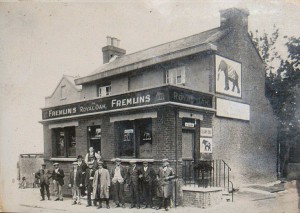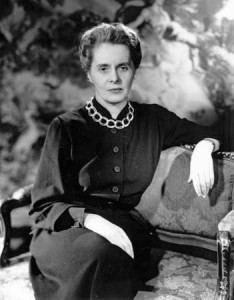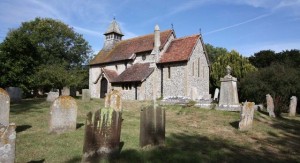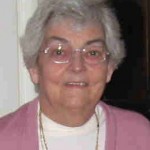The following article was written by Daphne Argent, and was published in the February 1999 issue of the magazine ‘Bygone Kent’. It follows on from ‘Whitfield within living memory (Part 1)’.
Whitfield, near Dover, was a rural community, with much employment being on the land. Agriculture does not allow for set finishing times or holidays and so for many people leisure activities were in the village, fitted in around their working hours.

Social life revolved around the Royal Oak public house run by John Goldsack Sayer and the Village Hall where activities as varied as Sunday School, Guide meetings, Mother’s Union, Garden Produce Shows and Whist Drives took place. In later years, the Whitfield Club House was built, not the present building, but something far more modest where snooker and darts and the weekly Saturday social were held. Gradually community activities were transferred here from the village hall. There was a village cricket team and one year they only needed to beat ‘Minerva’ to win the local league. They did not succeed! When Dover became more accessible, trips were taken to the cinema but you very often missed the end of a film because the 9.25 bus from town was insisted upon Any later and the soldiers from Old Parks Barracks would be returning from an evening out and they were not good travelling companions.
The highlight of the summer in the early 1950s was the village fete. This was held in the grounds of Whitfield Hall owned by the ‘Warre Bradleys’. This annual event, with its bowling for the pig, swing-boats, coconut shies and children’s races was not to be missed. The chance to dance on the lawns after dark, with lights among the trees and big band music playing on the gramophone, was eagerly awaited by the girls of the village. Which of the local boys would claim them for this romantic interlude? (How tame it would seem to today’s clubbing teenage generation.) Mrs

Bradley bred St Bernard dogs and she would walk around on fete days with several of these large but friendly animals on leads. One year she was accompanied by someone who was to become internationally famous, her daughter, Ninette (later Dame Ninette) de Valois. At the time, the local people could not have realised that they were meeting the future ‘Madame’ of English ballet. She recently appeared on her 100th birthday TV programme looking remarkably like her mother, as remembered from those days fifty years ago. The Hall has long since been sold and the grounds are now covered in bungalows.
‘To write about ballet and ballerinas is a reminder that Mrs Bradley must be tremendously proud of the triumphs which her daughter Miss Ninette de Valois has just achieved in America with her Covent Garden Company. It appears that America was taken by storm and many Whitfield people who saw Miss de Valois at the Summer Fete will be delighted at a success which has scarcely been equalled by an English company touring America.’
[Excerpt from Parish Magazine, St Peter’s, Whitfield, January 1950]
Famous people and unusual happenings do not figure very often in village life and so anyone out of the ordinary generated much interest. One such person was Rev. Alec Sargent (later to be Canon Sargent of Canterbury Cathedral). The nearest railway station to Whitfield was Kearsney and people would walk up from Temple Ewell, down past Jerusalem Cottages to Nursery Lane on their journeys to the village. The Rev. Alec Sargent was a regular traveller in his way. He was based at Canterbury and came to visit his mother Mrs Sargent, who lived at Sunny Side on the corner of Napchester Road with her companion Minnie. The sight of him dressed in full black clerical dress always caused comment, especially among the children.
Another unusual and rather sad happening took place in 1947. I mentioned the Royal Oak public house and if you look in the St Peter’s Church records for that year you will find a reference to the burial of Jessie Pease that quotes the Royal Oak as the place of death. The grave of this lady can still be found in the churchyard and behind it lies a sad story. In Nursery Lane, there are two semi-detached houses, ‘Helenor’ and ‘Radnor. ‘Helenor’ was occupied for many years by Miss Jane George, a lady of great age who eventually died in 1947. The house was put up for sale and caught the eye of a couple who, having lived in South America for some years, were now retiring to England, Mr and Mrs Pease. While they were negotiating the purchase they stayed in the Royal Oak. Sadly Mrs Pease was taken ill and died very suddenly while staying there. She was buried at St Peter’s and Mr Pease withdrew from the property purchase and left the area. As time passes there will be fewer and fewer people who will remember the story behind the lonely headstone.
The other house in the pair, ‘Radnor’, had a large garden and an orchard that ran along the back of other houses in Nursery Lane. The orchard was home to chickens and bantams which lived among the plum, damson and bullace trees and these could be tended, along with the vegetable garden, late into the night because of Double Summer Time. I remember that even washing could be hung out at 10 o’clock at night in daylight. The house had an Anderson shelter which was shared with ‘Helenor’. Its use was limited as the understairs cupboard was the preferred refuge during an air raid. However, just before D-Day in 1944 the military were encamped in a field behind the houses and this was subject to incendiary attack. The Anderson shelter was definitely used that night.

St Peter’s Church was at Church Whitfield and was outside the developed part of the village The vicarage was Rolles Court, a large white house just opposite the church. It was lived in by the Rev. Fortescue Thomas and his family. He rode a motorbike, taught at Dover College and ran the local Scout troop. His wife ran the Girl Guides and these two organisations used the grounds of the vicarage for camps and other meetings. Later the vicarage moved into Newbury Cross Lane and so this became the venue for church activities.
Harvest Festivals at St Peter’s were times of plenty, with large marrows, sheaves of corn and so many gifts of vegetables and fruit that every window sill and ledge was full to overflowing. With the church door open you could see grass waving in the churchyard outside as a packed congregation sand ‘We plough the fields and scatter’, with great gusto. The church had a bellows organ that had to be pumped by hand. Peggy Whitehouse and Mr and Mrs Barwick were the organists and Nellie Smith worked the bellows. At Christmas and Guides and Scouts read the lessons at the Carol Service and then walked the mile home in the dark. Usually, the winter evening service was brought forward to 4 o’clock so that people could make the journey in daylight. There was only one bell and this was rung, by Owen Wickes, for ten minutes before the start of a service. It could be heard back in the village and you walked a little faster if you were some way away from the church when it started to toll. Very few villagers had cars in those days and the journey to Sunday services was often wet and cold, but there was usually a good congregation despite the weather.
After the war, there was a great deal of house building in the village and three new blocks of Council houses were soon occupied when they were completed in 1947. Gradually the houses crept further and further along Nursery Lane and Archers Court and filled in the spaces in Bewsbury Cross Lane, the population grew and grew. Landmarks began to disappear; the little stone cottage at the entrance to the Old Park Barracks made room for new army quarters and road improvements ‘French’s’ house in Archers Court was demolished and new buildings put in its place; the orchard at Sparrow Court that had been tended by Mr Bayley became a cul-de-sac of bungalows, Orchard Close. The post office moved to a new building in Sandwich Road and Guilford Nursery and the village hall later disappeared. There was, however, a new Community Centre and eventually a village school and more shops, but these came after I left the village. All of these changes have had a cumulative effect on the village and when the name Whitfield started to appear on the road signs along the A2 it was an indication that it had an identity in modern times.
When I return now I still look for the familiar places of my childhood and recall the names, faced and events of the past, for to me, they were Whitfield. Sadly, so many of those faces and names are only to be found recorded on the headstones in the churchyard of St Peter’s Church. The village has moved on.
 Daphne Argent was born 13 March 1934 in the village of Whitfield, just outside Dover in Kent and died on 24 January 2014 in Rochester, Kent, just weeks before her 80th birthday. She was the daughter of Stan Hopper and Dorothy White.
Daphne Argent was born 13 March 1934 in the village of Whitfield, just outside Dover in Kent and died on 24 January 2014 in Rochester, Kent, just weeks before her 80th birthday. She was the daughter of Stan Hopper and Dorothy White.
Daphne spent years researching the history of her ancestry and was fastidious in her methods. In the decades before the internet she spent many hours in local libraries trawling through parish records and census returns, traipsing through churchyards and cemeteries locating family gravestones and – unbelievable in today’s technological age – painstakingly wrote out family trees by hand (and frequently re-wrote them when corrections and updates were required). She built up connections with a worldwide network of fellow genealogists also keen to discover their Hopper roots. The quantity and quality of her work is valued greatly by many. Indeed, a large proportion of the data on the Willis Tree relating to my mother’s line comes from Daphne’s endeavours.
She is greatly missed – this article is presented here in her memory
